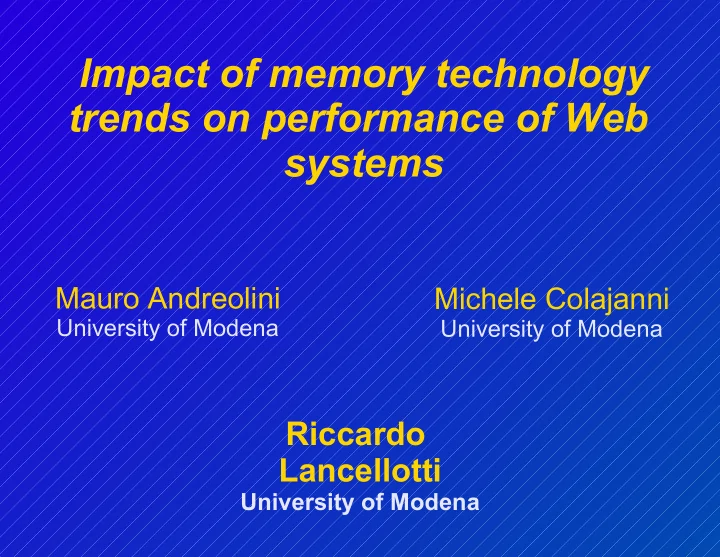

Impact of memory technology trends on performance of Web systems Mauro Andreolini Michele Colajanni University of Modena University of Modena Riccardo Lancellotti University of Modena
Characteristics of today's Web Complex Web-based services (dynamic Web ● content) Technology trends: ● Increasing capacity of network connections Growing amount of available memory (RAM) Memory embedded Year Cost [$/Mb] Typical Amount of RAM DBs will be com- 1995 20 128 Mb mon in a near fu- 2000 2 1 Gb ture even for large 2005 0,2 8 Gb Web sites 2010 0,02 64 Gb What is the impact of technology trends on Web system performance?
Multi-tier Web sites Client Network Middle Front-end Back-end tier tier tier Front-end tier: static Web resources, interaction ● with clients Middle tier: generation of dynamic Web resources ● Back-end tier: data repository (DBMS) ● Focus on available memory for the DBMS
Motivation Technology trends in memory lead to changes: ● In the system performance In the bottlenecks limiting the performance How do bottlenecks change as a function of technology trends? (no previous studies in literature) Bottleneck analysis is essential to plan system ● upgrade that can improve performance Need to understand and anticipate the effect of ● technology trends This approach can be applied to other Web-based ● applications and Web services Focus on O.S. and server software (Web, DBMS, application servers)
Experimental testbed Performance evaluation: ● Dynamic Web site ● When does a bottleneck Apache + PHP +MySQL appear? TPC-W like workload What is the bottleneck? Additional studies with ● Three memory scenarios: ● different technologies and All in-memory (100% of DB in workloads (not shown) memory) Fine-grained performance ● Partially in-memory (60%) analysis (sar, oprofile) Mostly on-disk (30%)
Page response time Impact of available memory on system capacity ( When does a bottleneck appear )
Page response time Analysis of the contribution to re- ● 3 sponse time by the three tiers The back-end tier contribution 2,5 drives the explosion of response time 2 → The bottleneck is on the DBMS Back- Confirmation of the impact of end tier ● 1,5 [s] DBMS on performance Middle tier [s] This is true for different ● Front- 1 end tier technologies and scenarios [s] PHP, J2EE 0,5 Multiple workload mixes and memo- ry scenarios 0 150 300 Bottleneck analysis focused on clients clients DBMS node Partially in memory scenario
Bottleneck analysis (Mostly on-disk scenario) Bottleneck identification ( What is the bottleneck ) : ● Low utilization of sockets Negligible utilization of CPU Full utilization of disk
Bottleneck analysis (Partial in-memory scenario) Bottleneck identification ( What is the bottleneck ) : ● Full utilization of sockets High utilization of CPU High utilization of disk
Bottleneck analysis (All in-memory scenario) Bottleneck identification ( What is the bottleneck ) : ● Low utilization of sockets Full utilization of CPU Negligible utilization of disk
Analysis of results The amount of available RAM on the DBMS has a signifi- ● cant impact on the causes of poor performance Little memory available → performance is bounded by ● disk throughput, Little system level interventions are available (reduced memory → caching effectiveness is reduced) hardware upgrade is the most effective approach (e.g, RAID systems, memory) More memory available → socket descriptors limit sys- ● tem performance high number of parallel requests can be a common situa- tion (e.g., preliminary study on network effects) should reduce request parallelism (e.g., replication of DBMS nodes, exploit of component-based systems)
Analysis of results Large amount of memory available → performance is lim- ● ited by asynchronous I/O (interaction with O.S. disk cache), Computationally expensive checksumming operations ● Should reduce asyn- chronous I/O (e.g., query caching) Message for the future: ● Interaction between O.S. disk cache and DBMS buffer cache can be inefficient and this can become a major bottleneck Need for efficient DBMS tailored for memory-embedded DB operations
Future work Evaluation of the impact of network ● Increasing capacity of network connections What is the impact of network technology trends on system performance and on system bottlenecks? Study with multiple applications and workloads ● Pub/sub systems (e.g., forums, blogs, ...) Web-based Auctions Web services WEB Lab group homepage http://weblab.ing.unimo.it/
Recommend
More recommend